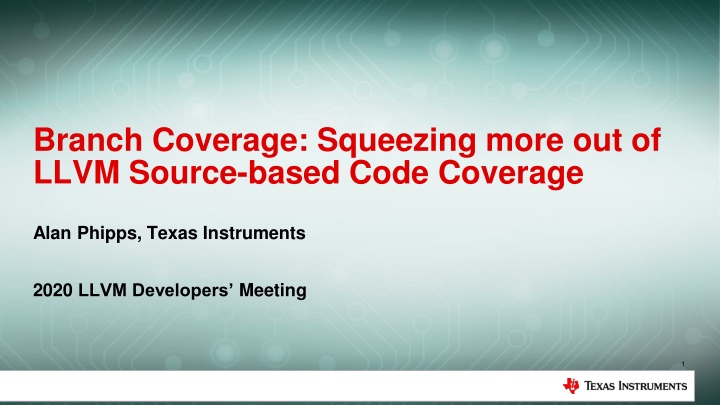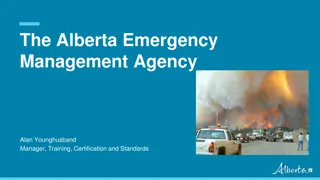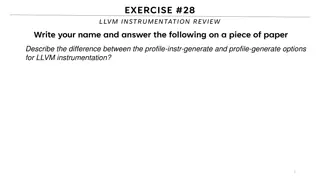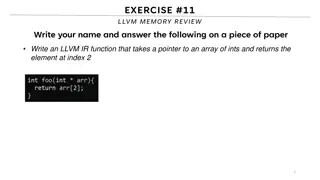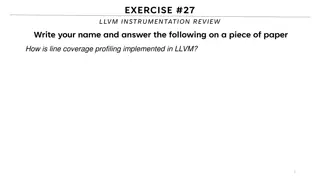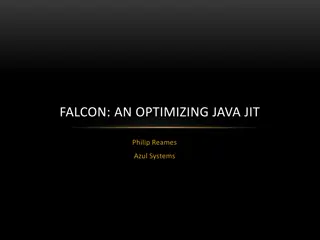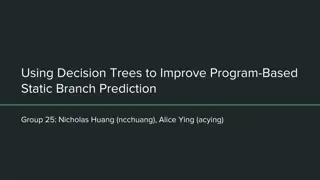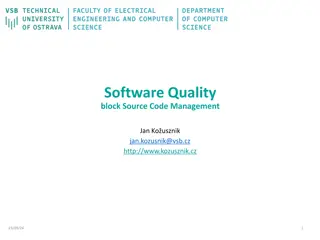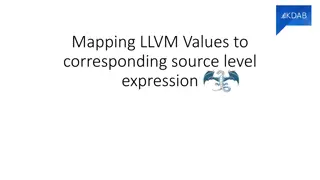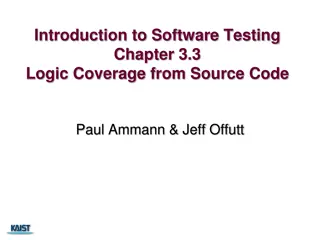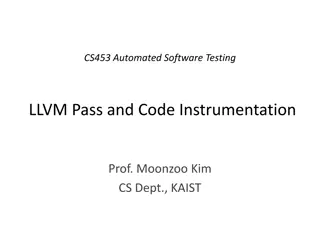Enhancing Branch Coverage in LLVM Source-based Code
Source-based code coverage in LLVM is essential for thorough testing, ensuring all code sections are executed. Learn about coverage criteria, phases like counter allocation, mapping, and instrumentation, and visualization tools for tracking coverage. Understand the importance of branch coverage and examine execution paths through the control flow.
Download Presentation

Please find below an Image/Link to download the presentation.
The content on the website is provided AS IS for your information and personal use only. It may not be sold, licensed, or shared on other websites without obtaining consent from the author.If you encounter any issues during the download, it is possible that the publisher has removed the file from their server.
You are allowed to download the files provided on this website for personal or commercial use, subject to the condition that they are used lawfully. All files are the property of their respective owners.
The content on the website is provided AS IS for your information and personal use only. It may not be sold, licensed, or shared on other websites without obtaining consent from the author.
E N D
Presentation Transcript
Branch Coverage: Squeezing more out of LLVM Source-based Code Coverage Alan Phipps, Texas Instruments 2020 LLVM Developers Meeting 1
What is Source-based Code Coverage? A measurement for how thoroughly code has been executed during testing Ideally all sections of code have an associated test Un-executed code may be at higher risk of having lurking bugs Supported Coverage criteria (in increasing level of granularity) Function Percentage of code functions executed at least once Line Percentage of code lines executed at least once Region Percentage of code statements executed at least once 2
Basic Phases (High Level) Counter Allocation and Counter-to-Source Region Mapping (clang) Counter Instrumentation in LLVM IR (clang) Test Execution Data Visualization (llvm-profdata & llvm-cov) 3
Counter Region Mapping and Instrumentation Counters are inserted into basic blocks of generated code mapped to source Counter1 instrumented to track Region (9:24 10:23) Function (line 9 foo()) Line (line 10) Statement: if-stmt line 9: bool foo(int x, int y) { Counter1++ line 10: if ((x > 0) && (y > 0)) Counter2 instrumented to track Region (10:18 10:25) Statement (y > 0) ^Counter2++ Counter3++ line 11: return true; line 12: line 13: return false; line 14: } Counter3 instrumented to track Region (11:0 11:12) Line coverage (line 11) (Counter1 Counter3) tracks Region (12:0 14:0) Line coverage (line 13) 4
LLVM Coverage Visualization LLVM Coverage Utility (llvm-cov) Text (llvm-cov) 8| | 9| 2|bool foo (int x, int y) { 10| 2| if ((x > 0) && (y > 0)) 11| 0| return true; 12| 2| 13| 2| return false; 14| 2|} ^1 5
Why is branch Coverage Important? Line | Cnt | 9| |bool foo(int x, int y) { 10| 4| if ((x > 0) && (y > 0)) ^1 11| 1| return true; 12| | 13| 3| return false; 14| 3|} Line | Cnt | 9| |bool foo(int x, int y) 10| 4|{ 11| 4| return ((x > 0) && (y > 0)); 12| 4|} ^1 There are two conditions on line 10 that form a decision: (x > 0), (y > 0) Line 11 shows that return true was executed once What was the execution path through the control flow that facilitated this? What was the execution path through the control flow around this? If we don t know, we can t be sure we are executing all paths! Branch Coverage tells us this! How many times is each condition taken (True) or not taken (False)? 6
LLVM Coverage Visualization + Branch Coverage Text (llvm-cov) LLVM Coverage Utility (llvm-cov) 9| 2|bool foo (int x, int y) { 10| 2| if ((x > 0) && (y > 0)) ------------------ | Branch (10:7): [True: 1, False: 1] | Branch (10:18): [True: 0, False: 1] ------------------ 11| 0| return true; 12| 2| 13| 2| return false; 14| 2|} 7
Goal: Ensure 100% Branch Coverage C short-circuit semantics on logical operators Testing all individual conditions also tests corresponding decisions foo(1, 0): (x > 0) = true (y > 0) = false (x > 0) && (y > 0) = false bool foo(int x, int y) { if ((x > 0) && (y > 0)) return true; foo(0, 1): (x > 0) = false (y > 0) = not executed! (x > 0) && (y > 0) = false return false; } foo(1, 1): (x > 0) = true (y > 0) = true (x > 0) && (y > 0) = true 8
Clang Source Region Creation Counter-to-Source Region Mapping (clang) Regions created based on AST walk Counter Instrumentation in LLVM IR (clang) Test Execution Data Visualization 10
CounterMappingRegion struct CounterMappingRegion { enum RegionKind { /// A CodeRegion associates some code with a counter. CodeRegion, /// An ExpansionRegion represents a file expansion region that associates /// a source range with the expansion of a virtual source file, such as /// for a macro instantiation or #include file. ExpansionRegion, /// A SkippedRegion represents a source range with code that was skipped /// by a preprocessor or similar means. SkippedRegion, /// A GapRegion is like a CodeRegion, but its count is only set as the /// line execution count when its the only region in the line. GapRegion, /// A BranchRegion represents leaf-level boolean expressions and is /// associated with two counters, each representing the number of times the /// expression evaluates to true or false. BranchRegion }; /// Primary Counter that is also used for Branch Regions (TrueCount). Counter Count; /// Secondary Counter used for Branch Regions (FalseCount). Counter FalseCount; unsigned FileID, ExpandedFileID; unsigned LineStart, ColumnStart, LineEnd, ColumnEnd; CounterMappingRegion associates a source range with a counter. It uses RegionKind to identify how to interpret its data. 1.) Extend RegionKind to include a new BranchRegion kind to represent branch-generating conditions 2.) Use existing Counter to represent True BranchRegion counts 3.) Add a second Counter to represent False BranchRegion counts 11
Counter Region Mapping (clang) Instrumentation profile Counters are already created for statement regions We can trivially reuse them to calculate Branch condition counts! A Counter can also refer to an arithmetic expression between two counters Counter1maps to Parent region Counter1++ if ( C ) { Counter2 maps to If-Stmt Then region Counter2++ For BranchRegion(C) C.TrueCounter = Counter2 C.FalseCounter = Counter1 Counter2 } This is true for all control-flow statements: if, for, while, switch, ternary ?: 12
Clang Counter Instrumentation Counter-to-Source Region Mapping (clang) ASTs lowered to LLVM IR Since we reuse counters, no special instrumentation needed! except Counter Instrumentation in LLVM IR (clang) Test Execution Data Visualization 13
Counter Instrumentation for Logical Operators Counter1maps to Parent region New Counter2maps to C2 , the right-hand-side, representing C2 execution count Counter1++ C short-circuit semantics on logical operators Counter2 increments only when C1 is false bool X = C1 || C2; || Counter3++ ^ Counter2++ For BranchRegion(C1) C1.FalseCounter = Counter2 C1.TrueCounter = Counter1 Counter2 For BranchRegion(C2) C2.FalseCounter = ? C2.TrueCounter = ? C2.TrueCounter = Counter2 Counter3 For BranchRegion(C2) C2.FalseCounter = Counter3 I have to instrument a new counter (Counter3) to track C2 s counts 14
Data Visualization Counter-to-Source Region Mapping (clang) Counter Instrumentation in LLVM IR (clang) Data Decoded and Statistics Calculated Test Execution Data Visualization (llvm-cov) 15
Visualization (llvm-cov) Decode mapping regions and filter based on Function and Macro Expansion Function (foo) - CodeRegion1 (9:24-10:23) - CodeRegion2 (11:0-11:12) - CodeRegion3 (12:0-14:0) BranchRegions: - BranchRegion1 (10:5-10:11) - BranchRegion2 (10:16-10:22) line 9: bool foo(int x, int y) { line 10: if ((x > 0) && (y > 0)) line 11: return true; line 12: line 13: return false; line 14: } Expansion (MAX) - CodeRegion1 (18:18-18:40) BranchRegions: - BranchRegion1 (18:19-18:24) line 18: #define MAX(x,y) ((x) > (y) ? (x) : (y)) line 19: bool bar(int x, int y) { line 20: return MAX(x,y); line 24: } Function (bar) - CodeRegion1 (19:24-24:0) - ExpansionRegion1 (20:10-20:13) 16
Visualization (llvm-cov) SubViews Extend notion of region SubView to include branches SubViews are demarcated nested views in the source-code Branches on the same line are grouped into the same SubView SubViews are also used to demarcate macro expansions Macro expansions can be recursive Macro expansions can contain conditions BranchCoverageInfo - Total # of Branches (2 per region) - # Branches executed at least once Extend summary reports to include Branch Coverage Add BranchCoverageInfo class 17
Branch Coverage Future Optimizations Better counter reuse for logical operators Nested conditions: bool myval = (C1 && C2 && (C3 || C4)); Enable HTML ToolTip hover capability on source conditions Hovering will reveal actual True/False Branch Counts Similar to how region coverage counts show up today Better identification of special branch regions Identify an implicitdefault Case in a switch statement Identify the sense of constant-folded conditions: always True or never True 18
Whats Next: MC/DC Ultimate Goal: Modified Condition/Decision Coverage (MC/DC) Percentage of all condition outcomes that independently affect a decision outcome Built on top of branch-coverage Usually involves emitting a truth table to confirm all possibilities 19
Observations on GCC Branch Coverage True/False Branch Data shown + Executed at least once - Not Executed (i.e. 0 ) Hover to see counts GCC HTML (LCOV) Difficult to tie branches to source Which branch goes with which condition? Which branch represents taken vs not taken? GCC Text (GCOV) function _Z3fooii called 2 returned 100% blocks executed 80% 2: 9:bool foo (int x, int y) { 2: 10: if ((x > 0) && (y > 0)) branch 0 taken 1 (fallthrough) branch 1 taken 1 branch 2 taken 0 (fallthrough) branch 3 taken 1 #####: 11: return true; -: 12: 2: 13: return false; -: 14:} In other contexts May see additional branches that aren t visible in source code Some branches may be removed GCC advises against using optimization with code coverage 20
GCC vs. LLVM LLVM HTML GCC HTML (LCOV) GCC Text (GCOV) LLVM Text function _Z3fooii called 2 returned 100% blocks executed 80% 2: 9:bool foo (int x, int y) { 2: 10: if ((x > 0) && (y > 0)) branch 0 taken 1 (fallthrough) branch 1 taken 1 branch 2 taken 0 (fallthrough) branch 3 taken 1 #####: 11: return true; -: 12: 2: 13: return false; -: 14:} 9| 2|bool foo (int x, int y) { 10| 2| if ((x > 0) && (y > 0)) ------------------ | Branch (10:7): [True: 1, False: 1] | Branch (10:18): [True: 0, False: 1] ------------------ 11| 0| return true; 12| 2| 13| 2| return false; 14| 2|} 21
Current State of LLVM Branch Coverage Implementation is complete -- in the process of upstreaming the work! Phabricator Review https://reviews.llvm.org/D84467 Should be included with stock LLVM Source-based Code Coverage A lot of ways to improve branch coverage! Want to be involved? Contact me! a-phipps@ti.com 22
Thank you! Acknowledgements Vedant Kumar, Apple Cody Addison, Nvidia Alan Davis, Texas Instruments 23
